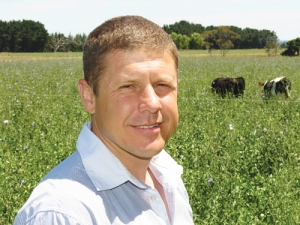Hogget breeding can increase the number of lambs weaned on a farm each year and increase lifetime performance, but only if done correctly.
A few simple rules should be followed this April/May for breeding to be successful. If not followed, performance can be poor, with negative lifetime consequences for the hoggets, says professor Paul Kenyon, Massey University.
He says hoggets need to be a minimum of 40kg liveweight at breeding (for a flock with a mature ewe breeding weight of 65kg).
"This minimum is an individual minimum and not a flock average. The greater the proportion hoggets are of their mature liveweight, the higher their performance. "Alternatively if body condition score is used a minimum of 2.5 is required," Kenyon explains.
"Hopefully farmers have been weighing their ewe hoggets regularly so they have an idea of how they are tracking and have plans in place if they are falling behind the target."
He adds that exposing hoggets to vasectomised rams (teasers) in mid- to late March can increase the proportion of hoggets bred successfully and those bred early in the breeding period.
"The rule of thumb for teasing is that the teasers are introduced to the hoggets 17 days -- and 17 days only -- prior to the first day of breeding. The teaser-to-hogget ratio should ideally be 1:70 although responses at a ratio of 1:200 have been found."
However, Kenyon points out that teasers should not to be used as a short term fix if hoggets are below 40kg at breeding.
"Teasing at these low weights may help these light ones get pregnant, but farmers are setting themselves up to fail."
Kenyon says hoggets are shy breeders and therefore a lower ram-to-hogget ratio is required than is used with mature ewes.
"To maximise breeding performance a ratio of 1:50 is ideal. Hogget rams are not ideal and if they are used the ratios need to be even lower," he adds.
"Studies have shown mature rams can be used for a cycle with mature ewes and then reused with hoggets without negatively affecting pregnancy ranks. When choosing a ram farmers need to consider the potential impact on birth weight. Sires or breeds that are likely to produce large heavy lambs at birth are not ideal due to the risk of birthing difficulties."
Hoggets need to gain about 20kg in total weight in pregnancy (including the weight of the placenta, foetus and associated fluids), which requires an average daily gain of 130g throughout the breeding period and in pregnancy.
"This allows for the hogget herself to grow and for the appropriate level of development for the foetus(es). Feeding hoggets well only in late pregnancy will result in most of the nutrition being partitioned towards foetal growth and the hogget will not grow."
Kenyon says this is very likely to result in increased rates of birthing difficulties (as the hoggett will still have a small frame) and she will be lighter than hoped for at weaning, which may impede two-tooth performance.
"Therefore, farmers need to have a plan for feeding their ewe hoggets appropriately throughout pregnancy. This needs to have begun by April."
- The International Sheep Research Centre team at Massey University, with funding from Beef + Lamb NZ and the C Alma Baker trust, have further hogget studies underway this year. The team is examining nutritional strategies prior to breeding and in lactation on alternative herbages; Dr Rene Corner and Dr Anne Ridler are leading a team examining risk factors for losses in pregnancies and around birth.



















